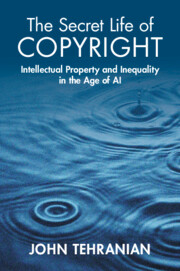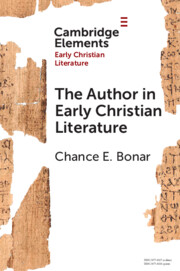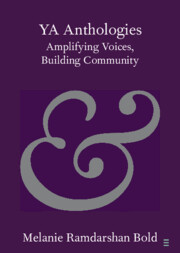Refine search
Actions for selected content:
171 results
Conclusion
-
- Book:
- AI versus IP
- Published online:
- 09 August 2025
- Print publication:
- 28 August 2025, pp 130-132
-
- Chapter
- Export citation
WHO MAKES THE PESTO? LABOUR, SOCIAL STATUS AND AUTHORSHIP IN THE MORETVM
-
- Journal:
- The Classical Quarterly , First View
- Published online by Cambridge University Press:
- 15 August 2025, pp. 1-15
-
- Article
-
- You have access
- Open access
- HTML
- Export citation

The Secret Life of Copyright
- Intellectual Property and Inequality in the Age of AI
-
- Published online:
- 08 August 2025
- Print publication:
- 14 August 2025
Chapter 1 - Genius
-
- Book:
- Landscapes of Genius and the Transatlantic Origins of Environmentalism
- Published online:
- 18 July 2025
- Print publication:
- 07 August 2025, pp 17-40
-
- Chapter
- Export citation
How Yesterday’s Plagiarism in Theology Affects the Scholarship of Tomorrow
-
- Journal:
- New Blackfriars / Volume 106 / Issue 4 / July 2025
- Published online by Cambridge University Press:
- 21 May 2025, pp. 329-345
- Print publication:
- July 2025
-
- Article
-
- You have access
- Open access
- HTML
- Export citation
The Imposition of Authorship: Michel Foucault’s Author-Function and Papias of Hierapolis on the Gospel of Mark
-
- Journal:
- Harvard Theological Review / Volume 118 / Issue 2 / April 2025
- Published online by Cambridge University Press:
- 30 July 2025, pp. 242-263
- Print publication:
- April 2025
-
- Article
-
- You have access
- Open access
- HTML
- Export citation

The Author in Early Christian Literature
-
- Published online:
- 27 January 2025
- Print publication:
- 20 February 2025
-
- Element
- Export citation
2.10 - The Market
- from History 2 - Mechanisms
-
-
- Book:
- The New Cambridge History of Russian Literature
- Published online:
- 31 December 2024
- Print publication:
- 12 December 2024, pp 388-406
-
- Chapter
- Export citation
1.1 - The Age of Devotion
- from History 1 - Movements
-
-
- Book:
- The New Cambridge History of Russian Literature
- Published online:
- 31 December 2024
- Print publication:
- 12 December 2024, pp 15-33
-
- Chapter
- Export citation
6 - Are Men and Women Creating Equal?
- from Part II - Intellectual Property and National Inequalities
-
-
- Book:
- Intellectual Property, Innovation and Economic Inequality
- Published online:
- 05 December 2024
- Print publication:
- 12 December 2024, pp 145-176
-
- Chapter
-
- You have access
- Open access
- HTML
- Export citation
8 - Precedential Opinions
-
- Book:
- Written and Unwritten
- Published online:
- 07 November 2024
- Print publication:
- 21 November 2024, pp 78-89
-
- Chapter
- Export citation
7 - Some Queer Entanglements in Lucian’s Erotes
- from Part I
-
-
- Book:
- The Cambridge Companion to Lucian
- Published online:
- 07 November 2024
- Print publication:
- 21 November 2024, pp 138-160
-
- Chapter
- Export citation
Chapter 9 - Fanfiction, Digital Platforms, and Social Reading
-
-
- Book:
- The Cambridge Companion to Literature in a Digital Age
- Published online:
- 29 November 2024
- Print publication:
- 14 November 2024, pp 154-176
-
- Chapter
- Export citation
Chapter 8 - The Literary Marketplace
-
-
- Book:
- The Cambridge Companion to Literature in a Digital Age
- Published online:
- 29 November 2024
- Print publication:
- 14 November 2024, pp 137-153
-
- Chapter
- Export citation
Chapter 1 - Life
- from Part I - Life and Career
-
-
- Book:
- Oliver Goldsmith in Context
- Published online:
- 28 November 2024
- Print publication:
- 07 November 2024, pp 3-11
-
- Chapter
- Export citation
Chapter 23 - Periodicals and Literary Reviewing
- from Part III - Literary Contexts
-
-
- Book:
- Oliver Goldsmith in Context
- Published online:
- 28 November 2024
- Print publication:
- 07 November 2024, pp 194-200
-
- Chapter
- Export citation
9 - ‘Receiving Rich Gifts’: Negotiating Power in the Metrical Paratexts of the Vossianus Gr. Q1
- from Part III - Poetry, Patronage and Power
-
- Book:
- Poetry in Byzantine Literature and Society (1081-1204)
- Published online:
- 17 October 2024
- Print publication:
- 31 October 2024, pp 225-255
-
- Chapter
- Export citation

YA Anthologies
- Amplifying Voices, Building Community
-
- Published online:
- 07 June 2024
- Print publication:
- 27 June 2024
-
- Element
- Export citation
7 - Framing the Freed Person
-
-
- Book:
- Freed Persons in the Roman World
- Published online:
- 16 May 2024
- Print publication:
- 23 May 2024, pp 189-216
-
- Chapter
- Export citation
Complete Artworks without Authors
-
- Journal:
- Canadian Journal of Philosophy / Volume 53 / Issue 7-8 / October 2023
- Published online by Cambridge University Press:
- 14 May 2024, pp. 666-677
-
- Article
-
- You have access
- Open access
- HTML
- Export citation
